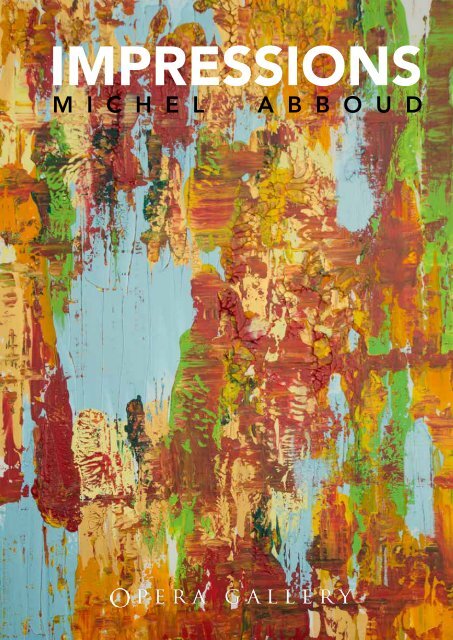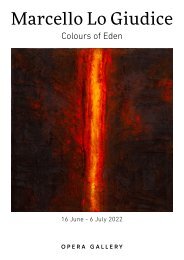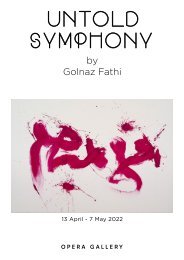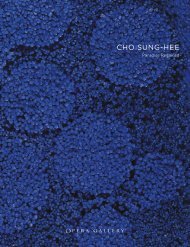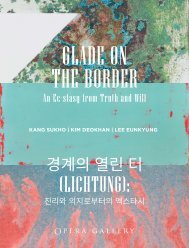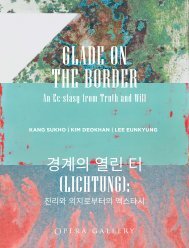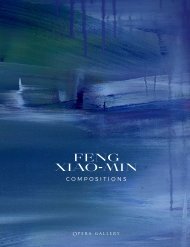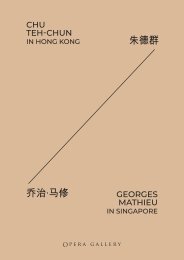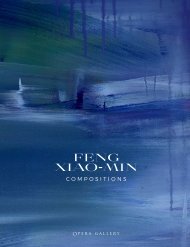Michel ABBOUD - Impressions : Sept. - Oct. 2019
You also want an ePaper? Increase the reach of your titles
YUMPU automatically turns print PDFs into web optimized ePapers that Google loves.
IMPRESSIONS<br />
M I C H E L A B B O U D
IMPRESSIONS<br />
M I C H E L A B B O U D<br />
17 SEPTEMBER - 1 OCTOBER <strong>2019</strong>
PREFACE<br />
Opera Gallery is delighted to present in Beirut for the first time a solo exhibition of New York<br />
based Lebanese artist <strong>Michel</strong> Abboud. ‘<strong>Impressions</strong>’ is a celebration of the artist’s recent works in<br />
his native land.<br />
Everything Abboud has created is connected with his heritage. His art is heavily influenced by<br />
his childhood in the war-torn environment of Beirut in the late 1970s and 1980s. Upon seeing his<br />
works, one is lead to reflect on the nature of conflict, whether inner or circumstantial. The act of<br />
painting appears to be more of a struggle between man and canvas, but in reality it is a clash<br />
between man and man, between one and one’s self. The dual conflicting nature of those questions<br />
is at the essence of his art process.<br />
The artist would describe his paintings as “non-paintings” because each art piece is only intended<br />
to represent itself. He believes that people have been so conditioned to perceive paint as a<br />
means to an end that they forgot to see it for what it really is. It can be molded, sculpted, layered,<br />
embossed, debossed, sanded and scraped. Abboud does not use only his hands, he uses his<br />
entire body as a tool. Does it make it a sculpture? What about the fact that it is a paint coated<br />
canvas? Doesn’t that defy its reading as a sculpture as well? Can it be both or does it have to be<br />
neither? Is this duality another conflict or a resolution of this paradox?<br />
By introducing Abboud to our esteemed collectors, we hope to bring to you this primal and<br />
sensorial experience that truly evokes the meaning of artworks. We hope you enjoy <strong>Michel</strong><br />
Abboud’s presence as much as we do.<br />
Gilles Dyan<br />
Founder and Chairman<br />
Opera Gallery Group<br />
Salwa Chalhoub<br />
Director<br />
Opera Gallery Beirut
PAINTINGS<br />
Gemini | Layered | Impression<br />
This exhibition showcases my work of the past two years.<br />
It starts out with my very first Gemini Series 4x4 feet diptych paintings, which then evolved into to<br />
my large format layered pieces that are heavily influenced by a mix of childhood experiences in a<br />
war-torn country and tumultuous experiences in New York over the last few years. The exhibition<br />
then leads to my latest sculptural pieces of folded canvas on canvas that came as a result of years<br />
of experimentation with the materiality of form and content.<br />
The Gemini Series is not intended to represent anything other than itself. I use high viscosity acrylic<br />
paint with no brushes and no knives- just my hands, while using my entire body as a tool to cover<br />
the large format canvases laid on the ground.<br />
With this series, one painting on canvas is created with texture and another canvas is overlaid on<br />
top which is then ripped apart to become a sister canvas and a new piece of art. The subsequent<br />
sister piece carries the residual scars and traced of the initial outburst. One is a continuation of the<br />
other. Even though one is a negative and the other is a positive, neither one is identical. One is an<br />
emotional piece and the other is a release piece, which come hand in hand. Both architecture and<br />
art are linked, identities are blurred but also merged. The dual conflicting nature of this process is<br />
at the essence of my art.<br />
On the other hand, the diptychs address the dual nature of man. Just like a Rorschach test, the<br />
dual piece replicates itself in complementary but non-identical way, the end of one marking the<br />
beginning of the other.<br />
I see my pieces as “non-paintings” because each art piece is not intended to represent anything<br />
other than itself. We have been so conditioned to perceive paint as a medium to achieve a final<br />
product that we forgot to see it for what it really is. Paint is paint, a material, colored matter, just a<br />
paste, no longer a medium of abstract or figural representation. It can now be molded, sculpted,<br />
layered, embossed, sanded and scraped, and by such take on an entire new meaning.<br />
GEMINI<br />
SERIES
Gemini in Copper (diptych), <strong>2019</strong><br />
Acrylic on canvas<br />
120 x 240 cm<br />
47.2 x 94.5 in
Gemini Tempest, <strong>2019</strong><br />
Acrylic on canvas<br />
120 x 240 cm<br />
47.2 x 94.5 in
Gemini in Gold (diptych), <strong>2019</strong><br />
Acrylic on canvas<br />
120 x 240 cm<br />
47.2 x 94.5 in
Gemini VII (diptych), <strong>2019</strong><br />
Acrylic on canvas<br />
180 x 180 cm<br />
70.9 x 70.9 in
Gemini VI (diptych), 2018<br />
Acrylic on canvas<br />
120 x 240 cm<br />
47.2 x 94.5 in
Papillon (diptych), <strong>2019</strong><br />
Acrylic on canvas<br />
120 x 240 cm<br />
47.2 x 94.5 in
Dragon (diptych), <strong>2019</strong><br />
Acrylic on canvas<br />
120 x 240 cm<br />
47.2 x 94.5 in
LAYERED<br />
SERIES
Layered black, 2018<br />
Acrylic and paper on canvas<br />
120 x 120 cm<br />
47.2 x 47.2 in
Sarah, 2018<br />
Acrylic and burlap on canvas<br />
180 x 160 cm<br />
70.9 x 63 in
Angela, 2018<br />
Acrylic and fabric on canvas<br />
180 x 160 cm<br />
70.9 x 63 in
IMPRESSION<br />
SERIES
Impression First Child, <strong>2019</strong><br />
Acrylic on canvas<br />
180 x 160 cm<br />
70.9 x 63 in
Impression Second Child, <strong>2019</strong><br />
Acrylic on canvas<br />
180 x 160 cm<br />
70.9 x 63 in
Discovery, <strong>2019</strong><br />
Acrylic on canvas<br />
180 x 160 cm<br />
70.9 x 63 in
Impression in Blue Metal, <strong>2019</strong><br />
Acrylic on canvas<br />
180 x 160 cm<br />
70.9 x 35.4 in
Impression in Gold (diptych), <strong>2019</strong><br />
Acrylic on canvas<br />
180 x 180 cm<br />
70.9 x 63 in<br />
Following pages:<br />
Impression Triptych I, <strong>2019</strong><br />
Acrylic on canvas<br />
180 x 270 cm<br />
70.9 x106.3 in
After investigating the possibilities of manipulating the actual paint matter in a sculptural and<br />
material process, I have then proceeded to explore the physical support itself: the canvas. So many<br />
artists over time have manipulated the canvas in different ways. Some have left it blank, others<br />
painted in white or in various colors, some burned it, some stabbed it, and others tore it. I have<br />
chosen to fold it. By stripping it from its frame, then slicing it, in order to finally fold it on to itself,<br />
I aim to blur the distinctions between content and container, support and object, medium and<br />
product. The folded canvas freed from its frame can now take on a multitude of new forms and<br />
materiality.<br />
Each piece is unique and can never be replicated as each fold is unique – like a fingerprint – due<br />
to the complexity of the form. By taking on a variety of light sensitive colors, ranging from metallic<br />
hues to shades of darks, down to pure white, I am investigating the way form and color dynamically<br />
react to light depending on the temperature of light and the position of the viewer. Each piece<br />
uses traditional materials: regular paint on basic canvas, applied with a standard brush.<br />
FOLDED<br />
SERIES<br />
Yet by applying the amazingly simple process of the fold, what started out as a classic application of<br />
paint on canvas now becomes a remarkably complex array of forms that refract light in a multitude<br />
of ways, unconstrained by the two dimensional space of the flat canvas.<br />
The resulting piece blurs the boundaries between painting and sculpture, and opens a dialogue<br />
about the distinction between the two: is it a painting or a sculpture? In the end, it is an object in<br />
space, with a certain materiality, and a dynamic reactivity to light, intended to only be appreciated<br />
for what it is, as opposed to what it is not.
Folded Black Gold, <strong>2019</strong><br />
Acrylic, metallic paint and canvas on canvas<br />
120 x 120 cm<br />
47.2 x 47.2 in
Folded Black II, <strong>2019</strong><br />
Acrylic, metallic paint and canvas on canvas<br />
120 x 120 cm<br />
47.2 x 47.2 in
Folded Black Metal, <strong>2019</strong><br />
Acrylic, metallic paint and canvas on canvas<br />
180 x 90 cm<br />
70.9 x 35.4 in
Folded Bronze, <strong>2019</strong><br />
Acrylic, metallic paint and canvas on canvas<br />
180 x 120 cm<br />
70.9 x 47.3 in
Folded Chrome, <strong>2019</strong><br />
Acrylic, metallic paint and canvas on canvas<br />
180 x 90 cm<br />
70.9 x 35.4 in
Folded Midnight, <strong>2019</strong><br />
Acrylic, metallic paint and canvas on canvas<br />
180 x 160 cm<br />
70.9 x 63 in
Folded White II, <strong>2019</strong><br />
Acrylic, metallic paint and canvas on canvas<br />
120 x 120 cm<br />
47.2 x 47.2 in
My parametric sculptures are a physical manifestation of the digital, in a technological world<br />
where the digital has replaced the spiritual. The omnipresence and omnipotence of digital space<br />
is sustained by the unequivocal presence of technology in every aspect of our daily lives. Our<br />
religious dedication to technology and the digital world has caused digital imagery to become the<br />
icons of our new system of belief.<br />
The pixel - the smallest unit of a digital image - is a digital atom that sculptures like Totem or<br />
Digital Versicolor represents three-dimensionally in the form of the agglomeration of hundreds of<br />
pristine cubes. The same way pixels aggregate to create an image, these three-dimensional pixels<br />
of various materials and colors are manipulated parametrically to create a physical object that<br />
represents the embodiment of the digital world.<br />
The centrality of Totem will reminisce indigenous ceremonies by very the act of gathering around<br />
an icon of belief. It will represent the central role technology has had in connecting us all. The<br />
structural impossibility that Digital Versicolor or Pixel Tree defy challenge the common notions<br />
of balance and equilibrium. But ultimately, the real paradox relies in the very fact that despite<br />
advanced digital scripting software generating the complex relationships between the 3D pixels,<br />
each sculpture is built by hand, in an artisanal way.<br />
SCULPTURES
Vine, <strong>2019</strong><br />
Solid cedar wood<br />
Edition of 3<br />
110 x 35 cm<br />
43.3 x 13.8 in
Erosion, <strong>2019</strong><br />
Painted stainless steel<br />
Unique piece<br />
190 x 50 cm<br />
74.8 x 19.7 in
Digital Versicolor, <strong>2019</strong><br />
Painted stainless steel<br />
Unique piece<br />
180 x 44 x 43 cm<br />
70.9 x 17.3 x 16.9 in
Pixel Tree, <strong>2019</strong><br />
Solid Cedar wood<br />
Unique piece<br />
180 x 56 cm<br />
70.9 x 22 in
MICHEL <strong>ABBOUD</strong><br />
<strong>Michel</strong> Abboud is an artist and an architect based in New York.<br />
He started his career by founding the award-winning architectural practice, SOMA. His designs<br />
have attracted critical acclaim for their boundary-pushing nature. Having earned a Masters in<br />
Architecture from the Columbia University, <strong>Michel</strong> built a reputation for provocative projects.<br />
<strong>Michel</strong>’s defiant no compromise stance, in terms of design, continuously raises the bar in the<br />
architecture sphere and has gained him respect among a loyal client base and fellow design<br />
professionals. His work is rising around the world today with remarkable offerings of projects<br />
that underscore his firm’s cutting edge appeal.<br />
He is known for designing the Park 51 Islamic Cultural Center a few blocks from Ground<br />
Zero in New York City, which further catapulted him into prominence, with one journalist<br />
dubbing him ‘the most controversial architect the US has known’. Such notoriety has led<br />
to a subsequent influx of invites as speaker and guest of honour at prestigious universities<br />
across the United States and Europe. Today, after winning numerous international awards, he<br />
is known for being one of the youngest architects to have designed a skyscraper in New York,<br />
at the age of 36, as well as a groundbreaking tower in Dubai.<br />
In recent years he has shifted his career from architecture to art, a shift that began by his<br />
combining art and architecture through the creation of large-scale parametric sculptures in<br />
various urban and rural landscapes around the world. His solo show at the Hoerle-Guggenheim<br />
Gallery in New York in 2018 was entitled “Unfolded” and covered his recent paintings which<br />
are heavily influenced by his childhood in a war-torn environment. He uses high viscosity<br />
acrylic paint with no brushes and no knives - just his hands, while using the entire body as a<br />
tool to cover the large format canvases laid on the ground.
Published by Opera Gallery to coincide with exhibition <strong>Impressions</strong>, 17 <strong>Sept</strong>. - 1 <strong>Oct</strong>. <strong>2019</strong>.<br />
All rights reserved. Except for the purposes of review, no part of this book may be reproduced,<br />
stored in a retrieval system, or transmitted, in any form or by any means, electronic, mechanical,<br />
photocopying, recording or otherwise, without the prior permission of the publishers.<br />
Foch 94, Foch Avenue, Beirut Central District, Lebanon<br />
+ 961 1 971471 | beirut@operagallery.com operagallery.com
operagallery.com


